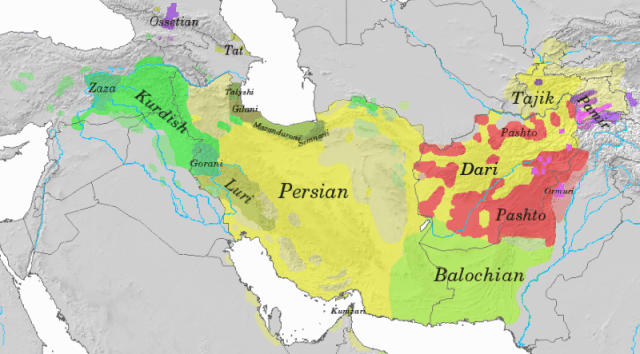Iranian identity is a whole that combines amplitude and density. This sense of identity is based on the solid awareness of belonging to one of the oldest civilizations of humanity, a civilization that encompasses a pre-Islamic but also Islamic heritage. Let us hasten to add, however, that unlike Arab countries where religion and ethnic identity are indistinguishable, Iranian culture also draws on a collective memory other than Islam, which allows us to envisage a more harmonious future between Iran and the rest of the world. Arab-Muslims have a much less cultural heritage; as a result, they are mentally less flexible, less able to perform certain exercises…
At the beginning of the revolution led by Ayatollah Khomeini, the clerical power tried to put an end to the symbols of ancient Persia and to make the history of this country begin with the arrival of Islam. This kind of manoeuvre, which poses no problem in Arab countries (starting with Saudi Arabia, the heart of Sunni Islam), does not operate among Iranians, considering their prodigious heritage. The maneuvers of the clerical power have only rekindled the Iranians’ attachment to this heritage. You only have to travel to Iran with your eyes wide open to realize this. It is also this collective attachment to such a memory that sustains my hope for a bright future between Iran and the world, in particular with Israel.
A few details on the Persian language, a language that has around one hundred million speakers, mainly in Iran, Afghanistan and Tajikistan, as well as in certain regions of Uzbekistan, without forgetting the Iranian diaspora. In Afghanistan, Persian is one of the two official languages (along with Pashtun). Persian is also the official language of Tajikistan. In Uzbekistan, the Persian language and culture are threatened by radical nationalism.
The Persian language is an Indo-European language derived from Middle Persian (Pahlavi) itself derived from Old Persian and Avestan (seeAvesta Zoroastrians). Pahlavi is related to Parthian (language of the North) and Middle Persian (language of the South) which will eventually supplant Parthian – while borrowing from it – to become the official language of the Sassanid Empire (224/226 – 651 AD . When the Arabs invaded Iran (in 651 AD), they wanted to impose their language. The Arab influence will be more noticeable in the South-West of the country than in the North-East (Khorassan region). And it is precisely in this region that Persian asserts itself from the 9th century, the Persian which will be written in Arabic characters. The Arabic-Persian alphabet has thirty-two letters, while the Arabic alphabet has only twenty-eight. Indeed, the Iranians had to add four letters in order to better render the sounds specific to their language.
 Map of Iranian languages
Map of Iranian languages
Under the protection of Iranian dynasties more or less independent of the Caliphate of Baghdad, Persian became the language of the Court and of the cities of Iran before becoming the second language of Islam after Arabic. It is a transnational language whose influence will extend from Anatolia to the North and Center of India, from the Caucasus to Transoxiana. From the second half of the 19th century, the Russian and English thrust will damage this influence.
The “Iranian world” is not limited to the current borders of Iran. This world ranges from the Zagros range (south of the Caspian Sea) to the western regions of China. Compared to the Arab and Turkish worlds, the “Iranian world” is certainly much older but also less homogeneous, with in particular the presence of significant minorities of Iranian languages other than Persian (Kurds, Pashtuns, Baluchis) and Turkish languages (Azeris , Turkmens, Uzbeks). However, and for more than a thousand years, the same cultural space has been structured, a pre-Islamic but also Islamic space. Islam was superimposed on the Zoroastrian background of the Iranian world, thus constituting a particularly rich universe which gave the Muslim world its greatest men of science, philosophers, mystics and artists (pictorial, musical, architectural arts). The “Iranian world” is therefore complex, fragmented and therefore fragile, but it remains dynamic through its diversity, a dynamism which makes this world potentially more open to the rest of the world, despite the terrible hazards of history and the serious geopolitical questions posed to us.
Iran is not only one of the very rare States which can boast of a history several thousand years old, but also of being at the origin of one of the first empires in history, the Achaemenid Empire founded by Cyrus the Great and his successors, notably Darius who not only enlarged it but, above all, endowed it with the best politico-administrative organization of his time. The Achaemenid Empire continues with Alexander the Great who has never ceased to consider himself the direct heir of Cyrus. It was only after the death of Alexander the Great that this empire was dismembered, and by his generals. Around 250 BC. AD begins a reaction against Hellenization with the formation of the Parthian Empire of the Arsacids, the Parthians who will have to fight against the Scythians and the Romans.
The Parthians were succeeded by the Sassanids (226-641 BC), Zoroastrians originating from Fârs, land of origin of the Persians, today a province of Iran, with Shiraz as its capital. The Sassanid Empire wants to be the continuation of the Achaemenid Empire which it will never reach the extension. The Arab invasion (640-650 AD) was greatly facilitated by the internal weakening of this empire.
The Arab invasion, Muslim therefore, marks a before and after in the history of this prestigious country. Iranians glorify the pre-Islamic period of the country and throw the following in the garbage. I am tempted by such an attitude, especially since I hold Arabs and Sunnism in low esteem, the Arab-Sunnis that I see as an evil to be fought, a pandemic. But the Iranians who are spiritually and intellectually very superior to the Arabs will recover the heritage of the invaders and enrich it prodigiously thanks to their pre-Islamic past and several thousand years. Thus, this invasion, a plague, will be absorbed and transfigured by Iranian genius. From the 9th century, we can evoke an Iranian renaissance born of the fusion of pre-Islamic references and the rather crude background of the Arab invaders.
Pre-Islamic Iran was a center of propagation and a crossroads of religious configurations: Zoroastrianism, Mithraism, Manichaeism. Buddhism has won the eastern confines of the empire. The Jews liberated from Babylon by Cyrus (in 53 BC) have been present in Persia since ancient times. Christianity (especially in its Nestorian form) finds refuge in the Sassanid Empire. The Iranians give Islam modulations and a richness that it did not have among the invaders.
Almost all Iranians are Muslims. Among them, about 10% of Sunnis who since the establishment of the Islamic Republic feel marginalized or even oppressed, a question all the more acute as it overlaps with that of ethno-linguistic minorities (Kurds, Baluchis, Turkmens, Arabs ) where Sunnism prevails, minorities who also live in peripheral regions that are generally less developed than the other regions of the country, hence the separatist tensions, centrifugal forces which are added to the centripetal forces, coming from outside , and who put pressure on the country; and I could go back to the feeling of encirclement that Iran has felt and is still feeling.
Christians, Jews and Zoroastrians are officially recognized and have representatives in Parliament. It is true that the number of Christians and Jews has significantly decreased since the Islamic Revolution, while the number of declared Zoroastrians has significantly increased. The Baha’is (an esoteric Shia movement born in Iran in the early 1790s) are probably the minority who suffer most directly from the regime. Their spiritual and administrative centers are located in Israel, Haifa and Acre. Despite the regime’s relative tolerance towards the Christian and Jewish minorities, to name but a few, it is preferable to be a Shiite in Iran in order to avoid hassles and complications.
In Iran, religion is not limited to the religion of the ulema; it does not disdain mysticism, Sufism (one of the foundations of Iranian identity) and philosophical reflection.
The relationship between politics and religion does not date from the Islamic period, it goes back a long way in the history of Persia. The Arab invasion and the Islamization of the country only strengthened this relationship. To understand the relationship between politics and religion in Muslim Iran, we must consider this breaking point that was the formation of the Safavid dynasty in 1501.
Little throwback. The fall of the Sassanid dynasty came shortly after the Arab invasion, with the death in 652 of its last emperor: Yazdegerd III. Iran does not become Muslim overnight, however, since the process of Islamization of the entire country will take several centuries. The western regions are the first to become Islamized, in particular through movements close to a kind of primitive Shiism, born in Mesopotamia and which seduce the Iranians for several reasons. Iranians experience themselves as relegated to a world dominated by Arabs who are overwhelmingly Sunni. Moreover, Zoroastrian thought feels more at ease in the messianic atmosphere of Shiism. Iranian thinkers will integrate part of the eschatological myths of Zoroastrianism into Iranian Shiite metaphysics. Moreover, a legend that has the force of truth reports that Ali’s youngest son, Hossein, would have married the daughter of Yazdegerd III. Thus the third imam, resulting from this marriage, would unite in his person the quality of imam and a Persian imperial ancestry.
From the Arab invasion to the advent of the Safavids, the politico-religious history of Iran can be divided as follows:
The Umayyad Caliphate (661-750) and the beginning of the Abbasid Caliphate. (750-1258). To put an end to the Umayyads, the Abbasids allied themselves with local Iranian dynasties, including Abu-Moslem Khorassani. Relations between these ad hoc allies end up deteriorating. The disrespect shown by the Arabs towards the very popular Abou-Moslem Khorassani is at the origin of a long series of uprisings of a politico-religious nature against the caliphate of Baghdad, a situation which favors the formation of many local dynasties. in the country. The period between the 9th century and the 13th century saw the weakening of the authority of the Abbasids, the revival of the Persian language and literature as well as an astonishing diversification of Shiism in a predominantly Sunni world. I pass over the list and the specificities of these dynasties and will content myself with noting that the political diversity of these local dynasties accompanies the religious diversity of Shiism, that these two diversities seem to mutually stimulate each other. However, despite these numerous and very active variously Shiite centers, the majority of Iranians remain Sunnis.
© Olivier Ypsilantis
Born in Paris, Olivier Ypsilantis studied art history and graphic arts. Fascinated since childhood by Jewish history and culture, he opened a blog in 2011, partly dedicated to them. Having lived in several countries, including twenty years in Spain, he recently moved to Lisbon.

